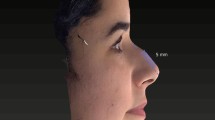Abstract
Introduction
Rhinoplasty is one of the most common procedures among esthetic and plastic surgery interventions. Hump deformities are prevalent among Caucasians, and amputation of the hump is the traditional approach in these patients. The traditional hump reduction procedure is still popular among rhinosurgeons, and research on the management of hump deformities is still being conducted to obtain better outcomes.
Objectives
The present study aimed to investigate the effects of upper lateral cartilage overlapping in patients who underwent dorsal preservation rhinoplasty.
Methods
In the present study, data from patients who applied to the author’s private clinic for hump deformities were screened. According to the inclusion and exclusion criteria, 47 patients were included in the study (39 females and 8 males). The evaluation of patients was performed with the Rhinoplasty Outcome Evaluation (ROE) scale. The combination of upper lateral cartilage overlapping with the let-down technique was assessed.
Results
There was no hump relapse in any of the participants. The median initial ROE score was 50.00, and the median ROE increased to 91.00 after 12 months. The change in the median ROE score was found to be significant (p < 0.001). The patient satisfaction rate according to the ROE scale was found to be excellent in 89.9% (40/47) of patients.
Conclusions
The combination of upper lateral cartilage overlapping with the let-down technique will provide an alternative approach for surgeons to operate on patients with a high hump and narrow dorsum. This technique will also result in better esthetic and functional outcomes with a lower risk of complications.
Level of Evidence IV
This journal requires that authors assign a level of evidence to each article. For a full description of these Evidence-Based Medicine ratings, please refer to the Table of Contents or the online Instructions to Authors www.springer.com/00266.










Similar content being viewed by others
References
Golshani S, Mani A, Toubaei S et al (2016) Personality and psychological aspects of cosmetic surgery. Aesthetic Plast Surg 40:38–47. https://doi.org/10.1007/s00266-015-0592-7
The International Society of Aesthetic Plastic Surgery (2017) The international study on aesthetic/cosmetic procedures performed in 2017. Annu ISAPS Int Surv Aesthetic/Cosmetic Proced, pp 1–18
Tuncel U, Aydogdu IO, Kurt A (2021) Reducing dorsal hump recurrence following push down-let down rhinoplasty. Aesthetic Surg J 41:428–437. https://doi.org/10.1093/asj/sjaa145
Lothrop OA (1914) An operation for correcting the aquiline nasal deformity; the use of a new instrument; report of a case. Bost Med Surg J. https://doi.org/10.1056/nejm191405281702205
Cottle MH (1954) Nasal roof repair and hump removal. AMA Arch Otolaryngol 60:408–414. https://doi.org/10.1001/archotol.1954.00720010420002
Drumheller GW (1995) The cottle push down operation. Am J Cosmet Surg 12:255–261. https://doi.org/10.1177/074880689501200307
Huizing EH (1975) Push down of the external nasal pyramid by resection of wedges. Rhinology 13:185–190
Saban Y, Daniel RK, Polselli R et al (2018) Dorsal preservation: The push down technique reassessed. Aesthetic Surg J 38:117–131. https://doi.org/10.1093/asj/sjx180
Öztürk G (2020) New approaches for the let-down technique. Aesthetic Plast Surg. https://doi.org/10.1007/s00266-020-01801-3
Öztürk G (2019) Scroll Ligament preservation and improvement in nasal tip with the room concept. Aesthetic Plast Surg. https://doi.org/10.1007/s00266-019-01436-z
Öztürk G (2021) Semi-let-down and semi–push-down preservation techniques: maintaining the intactness of the distal region. Aesthetic Surg J. https://doi.org/10.1093/asj/sjaa436
Öztürk G (2021) Combination of crossbar and let-down techniques for dorsal hump and septal correction in rhinoplasty. Ann Plast Surg 86:501–507. https://doi.org/10.1097/SAP.0000000000002818
Öztürk G (2020) Push-down technique without osteotomy: a new approach. Aesthetic Plast Surg. 44:891–901. https://doi.org/10.1007/s00266-020-01660-y
Öztürk G (2021) Partial let-down and push-down techniques with complete cartilage preservation. J Craniofac Surg 32:1126–1131. https://doi.org/10.1097/SCS.0000000000007119
Alsarraf R (2000) Outcomes research in facial plastic surgery: a review and new directions. Aesthetic Plast Surg 24:192–197. https://doi.org/10.1007/s002660010031
Montes-Bracchini JJ (2019) Nasal profile hump reduction using the let-down technique. Facial Plast Surg 35:486–491. https://doi.org/10.1055/s-0039-1695751
Tuncel U, Aydogdu O (2019) The probable reasons of dorsal hump problems following let-down / push-down rhinoplasty and solution proposals. Plast Reconstr Surg. https://doi.org/10.1097/PRS.0000000000005909
Tham T, Bhuiya S, Wong A et al (2022) Clinical outcomes in dorsal preservation rhinoplasty: a meta-analysis. Facial Plast Surg Aesthetic Med 24:187–194. https://doi.org/10.1089/fpsam.2021.0312
Skoog T (1966) A method of hump reduction in rhinoplasty: a technique for preservation of the nasal roof. Arch Otolaryngol Head Neck Surg 83:283–287. https://doi.org/10.1001/archotol.1966.00760020285020
Daniel RK (1989) Rhinoplasty: the retractable roof. Plast Reconstr Surg 83:976–83; discussion 984
Ishida LC, Ishida J, Ishida LH et al (2020) Nasal hump treatment with cartilaginous push-down and preservation of the bony cap. Aesthetic Surg J 40:1168–1178. https://doi.org/10.1093/asj/sjaa061
Author information
Authors and Affiliations
Corresponding author
Ethics declarations
Conflict of interest
The authors declare that they have no conflicts of interest to disclose.
Ethical approval
The present study was designed as retrospective and was not required ethical approval.
Informed Consent
A signed written informed consent were approved by all participants who were included in the present study.
Additional information
Publisher's Note
Springer Nature remains neutral with regard to jurisdictional claims in published maps and institutional affiliations.
Supplementary Information
Below is the link to the electronic supplementary material.
Supplementary file1 (MP4 71741 KB)
Rights and permissions
Springer Nature or its licensor (e.g. a society or other partner) holds exclusive rights to this article under a publishing agreement with the author(s) or other rightsholder(s); author self-archiving of the accepted manuscript version of this article is solely governed by the terms of such publishing agreement and applicable law.
About this article
Cite this article
Öztürk, G. Upper Lateral Cartilage Overlapping on the High Dorsum with the Let-Down Technique. Aesth Plast Surg 47, 2590–2597 (2023). https://doi.org/10.1007/s00266-023-03299-x
Received:
Accepted:
Published:
Issue Date:
DOI: https://doi.org/10.1007/s00266-023-03299-x




